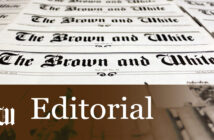October is the month of frights and screams. In the days leading up to Halloween, “Boo!” is shouted in haunted houses, and people seek thrills through scary movies.
While the scariest thing for most on Halloween may be an ugly clown, the scariest thing for political candidates in the days before Halloween is the October surprise. This political strategy is employed by campaigns in the last days leading up to the election. Candidates purposely release negative information about their opponents in this time period.
The October surprise tends to influence people’s perceptions of each candidate. Both Hillary Clinton and Donald Trump were affected by their opponent’s October surprise. As voters, it is sometimes difficult to sort through the strategic political moves to discern what is fact from what is fiction. As voters, it is imperative we look past the tricks and treats and vote based on which candidate aligns best with our personal beliefs.
The Clinton campaign’s October surprise were the tapes of Trump making sexist and inappropriate comments about women to Billy Bush in 2005. The Trump campaign’s October surprise could be noted as the press conference Trump held with women who accused Bill Clinton of sexual assault and Hillary Clinton of defending Bill Clinton’s actions.
In addition to these more traditional October surprises, the leaked emails of Clinton’s campaign chair, John Podesta, were a surprise, as well as the FBI’s decision to reopen the investigation into Hillary Clinton’s emails, even though the FBI is not supposed to act in a way that could influence the election. Trump’s partially-leaked tax returns and his possible ties to Vladimir Putin have contributed to the mess of this election season.
Even in one of the dirtiest election in modern political history, both candidates have suffered because of these surprises. The polls reflect the negative impact the information has on each candidate, and it is undeniable that the release of these items has at least some influence on voters.
While the information put out in October may be part of a strategic, manipulative move by both campaigns, the information presented can offer a glimpse into each candidate’s character. It may be a cheap trick, but it also may be true. This information can give voters an idea of what each campaign would like voters to focus on and think about. It reflects on the candidate publishing the information just as much as it reflects on the one being attacked.
Where voters find that information can vary, but they should work to avoid being stuck in an echo chamber of their own beliefs. In a Brown and White survey of 200 Lehigh students, 32.5 percent said they did not trust the media. Even with this, it is imperative voters look at candidate’s websites, what they have said and what they have done.
In the days leading up to the election, the boos heard are often from crowds protesting at political rallies instead of haunted houses. To avoid a scary result on Election Day, voters should make an informed decision Tuesday. To quote President Obama: “Don’t boo. Vote.”





Comment policy
Comments posted to The Brown and White website are reviewed by a moderator before being approved. Incendiary speech or harassing language, including comments targeted at individuals, may be deemed unacceptable and not published. Spam and other soliciting will also be declined.
The Brown and White also reserves the right to not publish entirely anonymous comments.